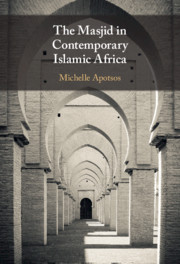Book contents
- The Masjid in Contemporary Islamic Africa
- The Masjid in Contemporary Islamic Africa
- Copyright page
- Dedication
- Contents
- Figures
- Preface
- Acknowledgments
- Introduction
- 1 Spaces Both Radical and Revolutionary: The Intersectional Masjid
- 2 Monument, Memory, and Remembrance: Rethinking the Masjid Through Contemporary Heritage Regimes
- 3 “All the Earth Is a Mosque”: The Masjid as Environmental Advocate
- 4 Masjids on the Move: Mobility and the Growth of “Portable” Islamic Space
- Conclusion
- Bibliography
- Index
3 - “All the Earth Is a Mosque”: The Masjid as Environmental Advocate
Published online by Cambridge University Press: 05 August 2021
- The Masjid in Contemporary Islamic Africa
- The Masjid in Contemporary Islamic Africa
- Copyright page
- Dedication
- Contents
- Figures
- Preface
- Acknowledgments
- Introduction
- 1 Spaces Both Radical and Revolutionary: The Intersectional Masjid
- 2 Monument, Memory, and Remembrance: Rethinking the Masjid Through Contemporary Heritage Regimes
- 3 “All the Earth Is a Mosque”: The Masjid as Environmental Advocate
- 4 Masjids on the Move: Mobility and the Growth of “Portable” Islamic Space
- Conclusion
- Bibliography
- Index
Summary
The third chapter continues discussions of conservation and preservation in the form of contemporary environmentalism and eco-criticism. To this end, the three case studies in this chapter address how masjid space functions as an expression of the relationship between man and the natural environment, and thus not only complement the natural world but actively work to maintain it. The first case study focuses on the kramats of Cape Town, South Africa and their utilization of a “natural aesthetic” that positions nature as something to be celebrated, venerated, and preserved. The second case study addresses the Djenne mosque in Mali, which not only deploys historical building technology toward creating a fundamentally environmentally friendly structure, but also potentially utilizes a biomimetic adaptation of the West African termite mound, whose superior heating, cooling, and organizational systems provide an excellent model on which to base a functional space. The final case study introduces Tanzania’s first “eco-mosque” as a prototype for the application of ecologically and spiritually responsible living in rural, low-income areas. Collectively, these case studies privilege the idea of masjid as a fundamentally eco-friendly spatial concept that can manifest in diverse forms and spaces.
- Type
- Chapter
- Information
- The Masjid in Contemporary Islamic Africa , pp. 132 - 183Publisher: Cambridge University PressPrint publication year: 2021



